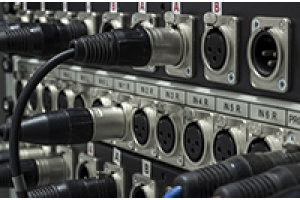Balanced input
A balanced input uses a 3 pin XLR connector. These are a single channel circuit, i.e. there is only one audio signal although 3 pins are used.
The three pins carry the following signals or part of signals.
Pin 1 is the ground/earth/return pin, no signal but the grounding which maintains a hum free output.
Pin 2 is the in-phase audio signal
Pin 3 is the anti-phase audio signal.
The point of having in-phase and an anti-phase signals is that the input of the mixer or amplifier will amplify the difference between these two signals. Under good conditions this simply means that the audio signal is twice as large as the original and everything is simply amplified and sounds good.
However balanced signals like this come into their own under interference conditions. Interference can be radio signal, mains hum or interference coming from lighting particularly lights that are dimmed or controlled as they are on stages. This interference attacks the signal wire and interferes with the audio equally on each signal wire. Then when the mixer or amplifier amplifies the difference between these two signals it does not amplify the interference because this is the same on each wire and the result is an audio output without any interference.
Of course, no system is perfect and a small amount of interference may get through although for those who like figures, the interference can be reduces by 60dB or more and is dependant on the quality of the balanced input of the amplifier. They quote characteristics such as common mode rejection which means how much signal which is identical on each wire is rejected rather than amplified and figures in the order of 60dB can be expected. 60dB is 1/1000th of the original.
A balanced input can be used with an un-balanced signal, e.g., output from a portable CD or MP3 player. To achieve this one signal pin, usually pin 3, is connected to ground or pin 1 and the signal input via pin 2. This gives an in-phase output signal but of course does not permit any interference rejection, but this is generally not important because the audio signal form an audio player is very much higher than the signal level from a microphone.

